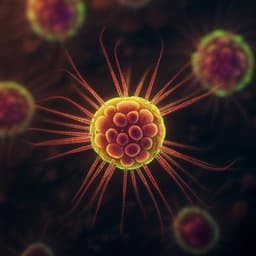
Chemistry
Unlocking bimetallic active sites via a desalination strategy for photocatalytic reduction of atmospheric carbon dioxide
X. Feng, R. Zheng, et al.
Discover the groundbreaking research by Xuezhen Feng, Renji Zheng, Caiyan Gao, Wenfei Wei, Jiangguli Peng, Ranhao Wang, Songhe Yang, Wensong Zou, Xiaoyong Wu, Yongfei Ji, and Hong Chen on a novel approach to enhance CO2 reduction efficiency using ultrathin 2D bimetallic oxyhalides. This innovative desalination technique opens new avenues for designing catalysts that could be pivotal in environmental and energy applications.
~3 min • Beginner • English
Introduction
The study addresses the challenge of creating ultrathin two-dimensional (UTN) bimetallic oxyhalide photocatalysts with well-defined compositions and dual-metal active centers for efficient photocatalytic CO2 reduction. UTNs offer large surface area, anisotropic charge distribution, and tunable band structures that benefit CO2 reduction reactions. Bismuth oxyhalides are especially promising due to layered structures with anisotropic electronic configurations and internal electric fields, which can be tuned via defects or doping. However, prior efforts have focused mainly on monometallic oxyhalides; bimetallic oxyhalide UTNs remain rare. The authors propose a top-down desalination strategy to selectively remove alkali-halide salt layers from a complex parent matrix (Pb0.6Bi1.4Cs0.6O2Cl2), unlocking bimetallic active sites and yielding ultrathin Pb0.6Bi1.4O2Cl1.4 layers to enhance light absorption, charge separation, and catalytic performance for atmospheric CO2 reduction.
Literature Review
Prior work has established UTNs as effective photocatalysts due to large surface areas, quantum confinement, and anisotropic electronic structures. Metal oxyhalide UTNs, especially bismuth oxyhalides, benefit from coexisting covalent metal–oxygen and ionic metal–halide bonding, generating internal electric fields favorable for charge separation. Reported performance enhancements include defect engineering and heteroatom doping (e.g., Co2+ in Bi3O2Br, V5+ in BiOIO, defect-engineered BiOBr). Various synthesis routes for UTNs have been explored (CVD, wet-chemical exfoliation, micromechanical cleavage, intercalation, acid-assisted etching), but these largely target monometallic systems. The scarcity of bimetallic oxyhalide UTNs with controlled stoichiometry and dual-metal active sites represents a gap this work aims to fill.
Methodology
Synthesis and desalination: The parent bulk matrix Pb0.6Bi1.4Cs0.6O2Cl2 (PBCOC) was synthesized via solid-state reaction under vacuum by grinding Bi, PbO, and CsCl in stoichiometric ratios, sealing, and heating to 800 °C for 5 days, followed by natural cooling to obtain white powder. A top-down desalination was then performed by dispersing PBCOC in deionized water and applying periodic ultrasonication (80 Hz, 100 W) over 14 days (3 h ultrasonication followed by 9 h standing, twice daily). Ultrathin Pb0.6Bi1.4O2Cl1.4 (PBOC) layers were collected by filtration. The desalination leverages the higher aqueous solubility of CsCl compared to Bi–Cl, Pb–Cl, Bi–O, and Pb–O bonds in the framework, enabling removal of Cs–Cl interlayers and delamination.
Characterization: Structure and morphology were examined by PXRD (Rigaku SmartLab, Cu Kα), AFM (MFP-3D, AC mode) for thickness, BET surface area via N2 adsorption/desorption (BELSORP-max), SEM (Zeiss Merlin) and HAADF-/BF-STEM with EDS mapping (FEI Titan Themis, 300 kV). Elemental valence states were probed by XPS (PHI 5000 Versaprobe III). Optical properties were measured via UV–Vis DRS (PerkinElmer Lambda 750S), PL (RF-5301PC), time-resolved fluorescence, Mott–Schottky plots, EIS, and transient photocurrent under 0.1 M Na2SO4 at 0.5 V vs Ag/AgCl.
Photocatalytic CO2 reduction tests: Gas-phase photocatalysis was carried out in a custom glass reactor under full-spectrum Xe lamp (300 W) or visible light (λ > 420 nm). A low CO2 concentration (~1500 ppm) was generated in situ by reacting NaHCO3 with H2SO4; atmospheric air (~500 ppm CO2) was also used. Catalysts (25 mg) were dispersed in water, dried onto a vessel, then humidified with 50 µL water. The vessel was placed above NaHCO3 in a sealed 200 mL chamber, purged with N2, evacuated, and injected with H2SO4 to produce CO2. Gas products were sampled periodically (200 µL) and analyzed by GC; isotopic tracing used 13CO2 and 18O labeling analyzed by GC–MS. Stability was assessed over four 4 h cycles.
Computational methods: Energetics of desalination were modeled by dividing the reaction into structural transformation and CsCl dissolution steps. DFT (VASP, GGA-PBE, PAW, 520 eV cutoff, 3×3×1 k-grid) computed reaction energies for structural change; experimental enthalpy (ΔHsol) was used for CsCl dissolution. Electronic structures and CO2RR mechanisms were computed with DMol3 (GGA-PBE, DNP basis, spin-polarized, Grimme vdW correction), using slab models (Bi-terminated PbBi1.40O2Cl1.4 (001), 2×2×1 supercell with 25% surface Pb). A COSMO water solvation model (ε=78.54) was applied. Free energies were evaluated using the computational hydrogen electrode model with zero-point and entropic corrections; a -0.41 eV correction was applied for CO. Le Bail refinement of PXRD employed GSAS-EXPGUI to confirm lattice parameters and space group (I4/mmm).
Key Findings
- Top-down desalination successfully removed Cs–Cl layers from PBCOC, yielding ultrathin bimetallic oxyhalide PBOC with formula Pb0.6Bi1.4O2Cl1.4.
- Structural/morphological metrics: AFM shows average thickness ~3.2 nm; PXRD peak broadening indicates reduced thickness and structural rearrangement; Le Bail refinement gives space group I4/mmm with a = 3.895 Å, c = 27.186 Å; HAADF-/BF-STEM confirms layered stacking (ABBA) and a ~4.0 Å in-plane lattice.
- Composition changes: STEM-EDS shows Cs reduced to ~0.05% (undetectable by XPS), Cl atomic concentration reduced to 21.73%; ICP-MS/AC reveal nearly 100% Cs+ and ~30% Cl− dissolved after 42 h ultrasonic treatment; ICP-MS on digested PBOC gives Cs/Pb/Bi = 0.02738/5.719/14.00 (Pb/Bi ratio matches 0.6/1.4). XPS indicates unchanged Bi, Pb, O, Cl valence states with slight binding energy shifts.
- Surface area: BET (N2) increases from 0.5963 to 2.561 m2 g−1 (4.3×). CO2 BET slightly increases (1.953 to 2.587 m2 g−1), attributed to loss of surface-adsorbed Cs+ that enhances CO2 condensation in the parent.
- Electronic/photophysical properties: Bandgap narrows from 3.14 eV (PBCOC) to 2.82 eV (PBOC). Mott–Schottky indicates n-type behavior with flat-band potentials of −0.29 V (PBCOC) and −0.19 V (PBOC); CBMs estimated at −0.44 V and −0.34 V vs NHE (pH 7). PBOC exhibits lower EIS charge-transfer resistance, reduced PL emission, larger transient photocurrent, and longer average fluorescence lifetime (from 1.59 ns to 2.69 ns), evidencing enhanced charge separation/transfer.
- Photocatalytic CO2 reduction (full spectrum, ~1500 ppm CO2): After 4 h, PBOC yields CO ~17.91 μmol g−1 and CH3OH ~26.53 μmol g−1 (7.2× and 7.3× higher than PBCOC), with CH4 also detected. O2 evolution ~48.69 μmol g−1 in 4 h; electron balance indicates coupling of reduction with H2O oxidation. Activity persists under visible light and when using atmospheric air (~500 ppm CO2), showing tolerance to O2. Performance is robust across 500–1500 ppm CO2 and seasons; higher temperature favors activity more than higher humidity. Stable over 4 cycles (16 h) with negligible performance or structural degradation.
- Mechanistic insights (DFT): Desalination energy requirement totals ~65.6 kJ mol−1 (47.3 kJ mol−1 to split CsCl layers; 18.3 kJ mol−1 to dissolve CsCl to 1 M aqueous ions), consistent with ultrasonication driving the process. Pb co-occupation enhances polarization and increases PDOS at the conduction-band edge on neighboring Bi (“meta-Bi”), strengthening electrostatic attraction to CO2 and inducing CO2 bending/activation; Mulliken charge on meta-Bi decreases from 0.807 to 0.194 upon Pb co-occupation. Free-energy pathways show CO desorption requires 0.262 eV; *CO → *CHO is exergonic by 0.651 eV; pathway energetics rationalize higher CH3OH yield than CO and lowest CH4 yield (predicted order: CH3OH > CO > CH4), matching experiments.
Discussion
The desalination strategy effectively unlocks and reconstructs bimetallic Pb–Bi oxyhalide active sites by selectively removing Cs–Cl interlayers from a complex parent matrix. The resulting ultrathin PBOC exhibits increased surface area, narrowed bandgap, optimized band-edge positions, and substantially improved charge separation/transport, directly addressing the need for efficient atmospheric CO2 reduction photocatalysts. Experimental and computational analyses converge to show that Pb co-occupation modulates the electronic structure (enhanced PDOS on neighboring Bi, stronger interfacial polarization), facilitating CO2 adsorption/activation and lowering kinetic/thermodynamic barriers along CO2RR pathways toward CH3OH. The robust performance under dilute CO2 (500–1500 ppm), in the presence of O2 (air), and over multiple cycles highlights the catalyst’s practical potential and stability. This approach demonstrates a generalizable route to engineer ultrathin bimetallic 2D oxyhalides with tailored active sites for environmental and energy applications.
Conclusion
A top-down wet-chemistry desalination strategy was developed to convert a complex layered parent material (Pb0.6Bi1.4Cs0.6O2Cl2) into ultrathin bimetallic oxyhalide layers (Pb0.6Bi1.4O2Cl1.4), unlocking abundant Pb–Bi active sites. The ultrathin PBOC shows superior light absorption, charge separation, and photocatalytic activity for atmospheric CO2 reduction, outperforming its bulk parent and representative bismuth-based monometallic oxyhalides. DFT and spectroscopy reveal that Pb incorporation enhances interfacial polarization and CO2 activation at meta-Bi sites, dictating favorable pathways with higher CH3OH yields. This desalination-enabled, top-down design provides a general strategy for fabricating ultrathin 2D bimetallic catalysts from complex matrices. Future work may extend this approach to other layered systems with alternating covalent and ionic layers, optimize metal ratios and surface terminations, and integrate co-catalysts to further tune selectivity and efficiency under real-world conditions.
Limitations
Related Publications
Explore these studies to deepen your understanding of the subject.







